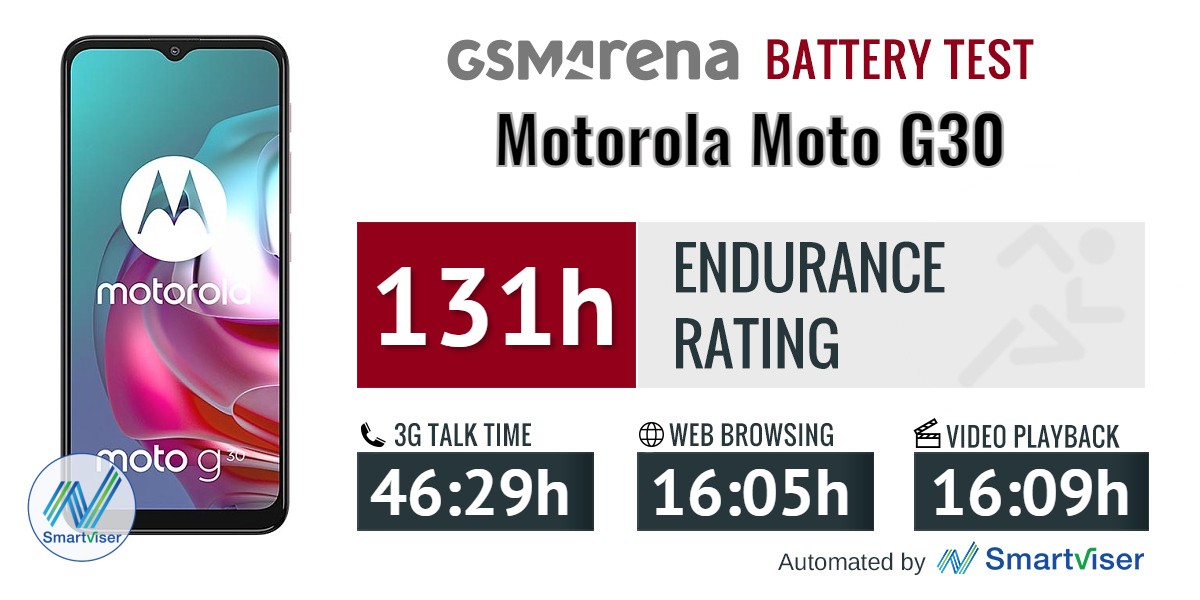Introduction
The famed Moto G has gone double-digits this year - Motorola is offering three numbered entrants in the lineup to go with the G Stylus, G Power and G Play from January, and we now have the Moto G10, G10 Power and G30. Abandoning continuity in search for diversity, the trio occupies different levels of the midrange, with the Moto G30 being the highest-specced one. Let's start with that one then.

The Moto G30's standout feature in this confusing crowd of phones is the high-refresh-rate display - moderately high at 90Hz, but certainly higher than the others. Otherwise, it's not really a head-turner - an LCD with a 720p resolution on a 6.5-inch diagonal is about as pedestrian as they come.
You could say the same of the Snapdragon 662, though we prefer to frame it more positively - as a balanced mid-tier performer that's both powerful and frugal, and a noticeable step up from the SD460s of the G10s.
The 64MP main camera, too, puts the Moto G30 above its immediate family, which top out at 48MP. The 8MP ultra-wide appears to be shared with the G10, G10 Power, and the G Stylus, going strictly by the numbers though there could be nuances to that. In any case, we have a G10 for side-by-side comparisons - all in due time.
Motorola Moto G30 specs at a glance:
- Body: 165.2x75.7x9.1mm, 200g; Glass front, plastic back, plastic frame; Water-repellent design.
- Display: 6.50" IPS LCD, 90Hz, 720x1600px resolution, 20:9 aspect ratio, 269ppi.
- Chipset: Qualcomm SM6115 Snapdragon 662 (11 nm): Octa-core (4x2.0 GHz Kryo 260 Gold & 4x1.8 GHz Kryo 260 Silver); Adreno 610.
- Memory: 64GB 4GB RAM, 128GB 4GB RAM, 128GB 6GB RAM; microSDXC (uses shared SIM slot).
- OS/Software: Android 11.
- Rear camera: Wide (main): 64 MP, f/1.7, 26mm, 1/1.97", 0.7µm, PDAF; Ultra wide angle: 8 MP, f/2.2, 118˚, 1/4.0", 1.12µm; Macro: 2 MP, f/2.4; Depth: 2 MP, f/2.4.
- Front camera: 13 MP, f/2.2, (wide), 1.12µm.
- Video capture: Rear camera: 1080p@30/60fps; Front camera: 1080p@30fps.
- Battery: 5000mAh; Fast charging 20W.
- Misc: Fingerprint reader (rear-mounted); NFC; FM radio; 3.5mm jack.
Other less standout but still feel-good bits on the Moto G30 include the 5,000mAh battery (which, it seems, has quietly become the standard capacity across many segments) and the 20W charging capability. A classic rear-mounted fingerprint sensor is a nice throwback to simpler times, as are the FM radio and headphone jack. Additionally, you'd be getting Android 11 out of the box, which remains something worth pointing out even some six months after the OS' release. Speaking of that box.
Motorola Moto G30 unboxing
The Moto G30 ships in Motorola's default one-piece navy packaging. Inside lies the phone, already in the supplied transparent soft case - protected even before you take it outside of the box.

You get a 20-watt charger (compare that to the 10W one supplied with the G10) that's rated at 5V/3A, 10V/2A, and 12V/1.67A. Also included is a USB-A-to-C cable. There is no headset in the bundle, as has been the norm with recent Motos.
Design
The Moto G30 has a fairly conventional design, livened up with two different color schemes and finishes, and then spiced up with a signature Moto touch.
The unit we spent the most time with for this review is in the Pastel Sky colorway. Naturally, it's not one color but a pearly pool of hues ranging from white through faint pink to lavender. That variant is glossy, and while it does pick up fingerprints, it doesn't really advertise them thanks to the light paintjob.

The other available color option is called Phantom Black (or Dark Pearl in different regions), and that one substitutes the gloss finish with satin - we'd say it's classier. It, too, plays with light, its hues ranging from petrol green to copper with maybe some magenta in between.
Regardless of color and finish, the Moto G30's rear panel is plastic and wraps around the handset's periphery, forming a unibody build with no exposed frame.
The glossy Pastel Sky feels a bit cheap in hand, and while we couldn't compare both units with the same hand on account of them being on opposite ends of the world, we're inclined to give the Dark Pearl one the nod for more upmarket feel.

Neither has the wavy textured back of the Moto G10, and that one is quite unique, if not necessarily posh.

The two handsets' backs share another common trait and that is the fingerprint reader. Fitted inside a very slightly recessed circle, the capacitive sensor is covered by the company's bat logo - so it serves for both authentication and as a design accent.

Advanced as underdisplay sensors have become, there is something inherently easy and effortless about just extending your index finger on the back of the phone to touch a plain capacitive sensor. The slow fade-in of the display waking up sort of robs some of the speed, so the perception isn't that of blazing fast unlocking, but it's okay.
Another small point we'd like to make is that the sensor doesn't offer much tactile feedback as to its location, so it takes some getting used to. The included case helps a lot with that.

The sort-of quad camera is grouped in a cluster in the top left corner, and the engineers did manage to fit everything together, even the LED flash. The assembly sticks out by about a millimeter, so it will introduce a slight wobble if you try to type on the phone when it's lying on a table. The included case fixes that, of course.

The black camera modules make for a stark contrast against the pale pink cover of the camera island on the Pastel Sky phone. Again, the alternative paintjob looks better, we'd say, with the black-on-green being a lot less in your face.

Both look the same on the front, however. The 6.5-inch display is slightly notched to accommodate the selfie camera, and the earpiece is directly above, behind a mesh. Both this mesh and the top bezel are on the thicker side, even if we account for the Moto's not-so-premium segment.

The bottom bezel is even thicker, yes, but the baseline for these is different, and the Moto G30 is about on par with every other budget-conscious offering in this respect.

The Moto G30 has a relatively unusual control layout. Both the power button and the volume rocker are on the left, and there's little special about them. What's out of the ordinary is the Google Assistant key high up near the top of the phone's right side.
Previous Motos would have that button on the left side, and a lot lower, where it's more easily accessible - a boon if you use it, a minor nuisance if you don't. On the G30 (and the G10, for that matter), it's placed such that you're unlikely to press it by accident, yet it's way out of reach if you do enjoy using Google Assistant. Oh, well.

We haven't really debated whether bottom or top works best for headphone jack placement, but judging by previous experiences, opinions will be polarized. The Moto G30 opts for what is seemingly the less common top position. In any case, the jack is present. A secondary mic pinhole keeps it company.
One thing fewer to see on the bottom then, where the G30 has the USB-C port, the loudspeaker and the primary mic.
Meanwhile, on the left side of the phone, you'll find the card slot. While you do a microSD slot in the tray, it's shared with the second nanoSIM forcing you to choose either one. Dedicated slots are better.



Headphone jack up top • USB-C on the bottom • Hybrid microSD slot on the left
The Moto G30 measures 165.2x75.7x9.1mm and weighs in at 200g. It doesn't stand out in any way in terms of size or heft for what it is - 6.5-inch midrangers with 5,000mAh batteries are all in the same ballpark. That said, it's a substantial phone and will not disappear in a pocket, even less so with the case on. But then again, that's mostly the norm, particularly for the class.

The Moto G30's LCD is low-res but high refresh rate
The Moto G30 is equipped with a 6.5-inch LCD with a modest 720x1600px resolution, and its pixel density works out to 270ppi - standard-issue numbers for the budget. The one number that stands out a little is the refresh rate - the G30's display supports up to 90Hz, and that makes it one of few devices in the company's lineup to go above 60Hz, plus it's also the cheapest of them.

But before we get to how it goes about handling the refresh rate, let's get brightness and contrast out of the way. The Moto G30 posted a fairly unremarkable 403nits with adaptive brightness disabled, which got a little boost to 468nits with the feature turned on and the phone placed under direct light. That is, however, the ballpark of the results in the segment, with only the Poco X3 shining notably brighter.
What the Moto G30 is great at, on the other hand, is contrast - thanks to its deep blacks, the Moto G30 scores almost 2000:1 for contrast, higher than any non-OLED competitor. In fact, the lesser Moto G10 has excellent contrast too, even if it's slightly lower than the G30's.
| Display test | 100% brightness | ||
| Black, |
White, |
||
| 0.204 | 403 | 1975:1 | |
| 0.241 | 468 | 1942:1 | |
| 0.197 | 370 | 1878:1 | |
| 0.31 | 457 | 1474:1 | |
| 0.374 | 526 | 1406:1 | |
| 0.252 | 395 | 1567:1 | |
| 0.277 | 439 | 1585:1 | |
| 0.259 | 435 | 1680:1 | |
| 0.325 | 521 | 1603:1 | |
| 0.341 | 484 | 1419:1 | |
| 0.337 | 413 | 1226:1 | |
| 0.412 | 471 | 1143:1 | |
| 0.292 | 398 | 1363:1 | |
| 0.349 | 472 | 1352:1 | |
| 0.239 | 381 | 1594:1 | |
| 0.32 | 437 | 1366:1 | |
| 0.354 | 460 | 1299:1 | |
| 0.515 | 631 | 1225:1 | |
As in many other areas, the Moto G30 adopts the AOSP approach to dealing with colors, with Natural, Boosted and Saturated modes at your disposal, Saturated being the default one. It's lacking wide color gamut coverage, so you can't expect faithful reproduction of DCI-P3 content, but Natural mode does get very close to accurate rendition of our sRGB test swatches. Still, we'd prefer the more vivid Saturated preset, despite its relatively cold white point.
The Moto G30 has three modes in its refresh rate menu - 60Hz, 90Hz and Auto. The first one will have you locked in 60Hz for all tasks, and that's what we'd expect of it. In 90Hz mode, you'd be getting 90Hz for pretty much every task, including video playback - not optimal behavior in terms of battery life, but one that's at least honest.
If you do want to optimize battery usage, the Auto mode will try and help with that by adjusting the refresh rate down to 60Hz as soon as you stop interacting with the phone - so you'd be getting 90Hz when you touch the screen and scroll around, but it will drop to 60Hz once you stop touching the screen.
Now, while that battery optimization sounds plausible in principle, we've previously seen that running LCDs in 90Hz rarely has any significant detrimental effect on battery life. That was our experience with the Moto G30. Hence, we'd just keep it at 90Hz all the time.
Motorola Moto G30 battery life
The Moto G30 relies on a 5,000mAh battery to make it through the day. Make it through the day it does, and then some. We measured 16 full hours in each of our screen-on tests, with the display set to 90Hz (so, effectively, 90Hz in both web browsing and video playback, all the time). We re-ran the tests in 60Hz as well and got essentially the same numbers, within the margin of error.
The phone then continued its strong performance with a 46-hour result in voice calls and recorded minimal standby draw. Ultimately, the Moto G30 posted an endurance rating of 131 hours.

Our battery tests were automated thanks to SmartViser, using its viSer App. The endurance rating above denotes how long a single battery charge will last you if you use the Motorola Moto G30 for an hour each of telephony, web browsing, and video playback daily. We've established this usage pattern so that our battery results are comparable across devices in the most common day-to-day tasks. The battery testing procedure is described in detail in case you're interested in the nitty-gritty. You can check out our complete battery test table, where you can see how all of the smartphones we've tested will compare under your own typical use.
Charging speed
The Moto G30 ships with a 20W adapter that's rated at 5V/3A, 10V/2A, and 12V/1.67A. Our best efforts to find out what standard it supports indicate it is QuickCharge 3.0 compliant, mostly based on the SD662 chipset specification - in any case, the adapter's numbers are a bit unusual.
Regardless of standard, the Moto G30 charges from flat to full in two and a half hours. Starting from zero, you'd be looking at 32% half an hour into the process. These are hardly record-breaking numbers, but we'd call them acceptable for the class.
30min charging test (from 0%)
- Realme 7
58% - Poco X3 NFC
55% - Honor 10X Lite
47% - Huawei P Smart 2021
42% - Motorola Moto G 5G
36% - Xiaomi Redmi Note 9T
33% - Motorola Moto G30
32% - Poco M3
25% - Xiaomi Redmi 9T
25% - Motorola Moto G10
22% - Motorola Moto G9 Power
20% - Samsung Galaxy A12
20%
Time to full charge (from 0%)
- Realme 7
1:05h - Poco X3 NFC
1:15h - Huawei P Smart 2021
1:42h - Honor 10X Lite
1:47h - Xiaomi Redmi Note 9T
1:50h - Motorola Moto G 5G
2:11h - Motorola Moto G9 Power
2:19h - Motorola Moto G30
2:28h - Poco M3
2:30h - Xiaomi Redmi 9T
2:30h - Motorola Moto G10
3:00h - Samsung Galaxy A12
3:03h
Speaker test
Unsurprisingly, the Moto G30 has a single speaker firing out the bottom of the device - stereo setups don't typically inhabit this price bracket. On the other hand, there were a couple of Moto G8s (Plus and Power) that did have stereo speakers, and the Power was priced in the G30 ballpark. Oh, well.

The Moto G30 scored an 'Average' rating for loudness in our loudspeaker test, same as the G10 we had for review. Oddly, the two do sound a little different, with the G30 being ever so slightly more likeable with its more colorful vocals and highs. Low-frequency response is about the same between the two. Mind you, a Realme 7 or a Poco X3 (NFC or otherwise) will be louder, with the Poco also offering stereo speakers.
Use the Playback controls to listen to the phone sample recordings (best use headphones). We measure the average loudness of the speakers in LUFS. A lower absolute value means a louder sound. A look at the frequency response chart will tell you how far off the ideal "0db" flat line is the reproduction of the bass, treble, and mid frequencies. You can add more phones to compare how they differ. The scores and ratings are not comparable with our older loudspeaker test. Learn more about how we test here.
Almost AOSP Android 11, some Moto mods
If you are looking at Motorola phones to buy, you are probably here because of the clean Android experience, Android 11 out of the box on the Moto G30. While the UI basics are, indeed, stock, Motorola has introduced a host of neat features that add value without getting in the way.

A single Moto app combines all the proprietary features. The first category is personalization allowing you to choose the icon shapes, the quick toggles appearance, the accent colors and the font. There is also a wide selection of wallpapers, the same ones you'd find in the Google Wallpapers app, plus some Moto-specific interactive ones.
Then come the gestures. The karate chop motion that turns on and off the flashlight is here along with the twisting motion that launches the camera app. Both work even when the device is locked. The lift to unlock gesture works well with the face unlock as it unlocks the device as soon as you pick it up and look at the screen. A new addition is the swipe to split function that triggers the split-screen functionality.
The display-related features are Peek Display and Attentive Display. The former works as a second-best alternative to the Always-on display but with some added functionality. The screen lights up when it detects motion that's close to the phone (most likely uses the proximity sensor) or when you pick it up. Once you've received some kind of notification, you can tap on it and see the message itself and even interact with it from the lock screen. As for the Attentive Display, it's pretty self-explanatory - it disables the screen timeout as long as there's a face looking at the screen. Pretty useful when reading long articles, though you do probably scroll often enough for the screen not to lock anyway.
Since Android 11 brings some new features of its own, Motorola has added a 'What's new' section to get you acquainted with those. The one-time permissions allow you to grant access to certain apps to your storage, location, contacts, etc., only temporary. You will be asked again when the app needs the said permission once more when you use it. Notification grouping is an effort to keep your notification shade tidy and focus on your conversations. Notification cards from ongoing conversations from your messaging apps will appear on top as high-priority compared to other app notifications.
Bubbles is one of the long-awaited features for messaging apps that Facebook's Messenger has had for years now. The apps that support the feature will prompt you with a notification in the form of a floating, interactive bubble. Tapping on it will open up the chart for a quick reply, just like Messenger.
Nearby Share with other Android devices a recent Android version is also possible, so transferring files has never been easier. And lastly, we have the updated power menu that now displays shortcuts to connected devices such as home automation or Chromecast through the Google Home app.






Lockscreen • Homescreen • Folder view • App drawer • Notifications • Quick toggles
The optimized charging feature is a new find that's not necessarily inherited from the Android 11 OS, but it basically does what all similar features from other brands offer. It learns your usage and charging patterns, so it doesn't 'overcharge' the battery, although this term isn't exactly correct. What it does is charge the handset to 80% and then delay the last 20% until right before you disconnect the adaptor. You need to toggle it on, though, as it's disabled by default.
The G30 being more powerful than the G10, we didn't really encounter any delays or hiccups in general operation across the UI and menus. The fingerprint reader, as we mentioned on the previous page, leaves a slightly unresponsive impression. It's not that it's slow to unlock - you get the vibration feedback when the fingerprint's scan is successful; it's just that lighting up the display takes a bit longer than usual.
Synthetic benchmarks
The Moto G30 is powered by the Snapdragon 662 chipset, a midrange piece of silicon introduced in 2020 and built on an 11nm process. It features an octa-core CPU in a 4+4 configuration with Kryo 260 Gold cores in the high-performance cluster (Cortex-A73-based) and Kryo 260 Silver ones (Cortex-A53-based) for less demanding tasks. The graphics department is handled by the Adreno 610 GPU.
Different RAM and storage options exist, from 4GB/64GB to 6GB/128GB, with our review unit being the base spec.

The Moto G30 posted predictable numbers in benchmarks, on par with other SD66x-equipped handsets. The Realme 7 with its beefier Helio G95 and the Poco X3 NFC with a 7-series SD732G are in a different league for CPU performance in GeekBench. The Galaxy A21s that you can get for Moto G30 money in most places isn't as powerful, while the more expensive A31 is slightly ahead in single-core, slightly behind in multi-core.
GeekBench 5 (multi-core)
Higher is better
- Poco X3 NFC
1777 - Realme 7
1681 - Motorola Moto G9 Play
1402 - Xiaomi Redmi 9T
1400 - Realme Narzo 20A
1400 - Poco M3
1398 - Motorola Moto G8 Power
1394 - Motorola Moto G9 Power
1374 - Realme Narzo 20
1328 - Realme 7i
1318 - Honor 10X Lite
1317 - Motorola Moto G30
1265 - Samsung Galaxy A31
1216 - Motorola Moto G10
1139 - Samsung Galaxy A21s
1100 - Samsung Galaxy A12
1034 - Samsung Galaxy A02s
495
GeekBench 5 (single-core)
Higher is better
- Poco X3 NFC
568 - Realme 7
536 - Realme Narzo 20
385 - Samsung Galaxy A31
352 - Motorola Moto G9 Power
315 - Motorola Moto G9 Play
314 - Realme Narzo 20A
314 - Realme 7i
312 - Motorola Moto G8 Power
311 - Poco M3
308 - Xiaomi Redmi 9T
307 - Motorola Moto G30
306 - Honor 10X Lite
300 - Motorola Moto G10
247 - Samsung Galaxy A21s
184 - Samsung Galaxy A12
169 - Samsung Galaxy A02s
131
This is more or less the way things stand in Antutu - Moto G30 is a bit more powerful than the Galaxies in the price range, on par with the SD66x competitors, and way behind the Realme 7 and the Poco X3.
AnTuTu 8
Higher is better
- Realme 7
292828 - Poco X3 NFC
283750 - Realme Narzo 20
193912 - Motorola Moto G9 Power
182875 - Xiaomi Redmi 9T
177917 - Poco M3
177904 - Motorola Moto G8 Power
173607 - Realme 7i
172933 - Motorola Moto G30
170968 - Motorola Moto G9 Play
170064 - Realme Narzo 20A
169543 - Honor 10X Lite
161375 - Samsung Galaxy A31
151815 - Motorola Moto G10
140230 - Samsung Galaxy A12
107189 - Samsung Galaxy A21s
107157 - Samsung Galaxy A02s
90811
When it comes to GPU oomph, the Moto G30 has just the right amount of it for its 720p display and puts out respectable fps numbers in the onscreen tests in GFXBench. The Realme 7 and the Poco X3 remain ahead, even with their higher-res 1080p screens, with the gap widening in raw-power offscreen tests.
GFX Manhattan ES 3.1 (offscreen 1080p)
Higher is better
- Realme 7
34 - Poco X3 NFC
33 - Realme Narzo 20
16 - Honor 10X Lite
15 - Motorola Moto G30
14 - Motorola Moto G9 Play
13 - Poco M3
13 - Motorola Moto G9 Power
13 - Xiaomi Redmi 9T
13 - Motorola Moto G8 Power
13 - Realme Narzo 20A
13 - Samsung Galaxy A31
13 - Realme 7i
13 - Motorola Moto G10
9.4 - Samsung Galaxy A21s
9.4 - Samsung Galaxy A12
7.7 - Samsung Galaxy A02s
6.1
GFX Manhattan ES 3.1 (onscreen)
Higher is better
- Realme Narzo 20
32 - Realme 7
28 - Poco X3 NFC
27 - Motorola Moto G30
26 - Motorola Moto G9 Play
26 - Motorola Moto G9 Power
26 - Realme Narzo 20A
26 - Realme 7i
25 - Motorola Moto G10
19 - Samsung Galaxy A21s
19 - Samsung Galaxy A12
13 - Honor 10X Lite
13 - Motorola Moto G8 Power
12 - Samsung Galaxy A31
12 - Samsung Galaxy A02s
12 - Poco M3
11 - Xiaomi Redmi 9T
10
GFX Car Chase ES 3.1 (offscreen 1080p)
Higher is better
- Realme 7
20 - Poco X3 NFC
19 - Realme Narzo 20
16 - Honor 10X Lite
8.2 - Samsung Galaxy A31
8 - Xiaomi Redmi 9T
7.5 - Motorola Moto G30
7.3 - Poco M3
7.2 - Motorola Moto G9 Power
7.2 - Realme Narzo 20A
7.2 - Motorola Moto G8 Power
7.1 - Motorola Moto G9 Play
7 - Realme 7i
7 - Samsung Galaxy A21s
6 - Motorola Moto G10
5.2 - Samsung Galaxy A02s
3.4 - Samsung Galaxy A12
3.3
GFX Car Chase ES 3.1 (onscreen)
Higher is better
- Realme Narzo 20
18 - Realme 7
17 - Poco X3 NFC
16 - Motorola Moto G30
13 - Motorola Moto G9 Play
13 - Motorola Moto G9 Power
13 - Realme Narzo 20A
13 - Realme 7i
13 - Samsung Galaxy A21s
11 - Motorola Moto G10
9.2 - Samsung Galaxy A31
7 - Honor 10X Lite
7 - Motorola Moto G8 Power
6.6 - Samsung Galaxy A02s
6.1 - Poco M3
5.9 - Xiaomi Redmi 9T
5.8 - Samsung Galaxy A12
5
64MP primary cam and 8MP ultrawide, somewhat odd app
The Moto G30 has what can be described as the best camera system in the G lineup at the time. It's headlined by a 64MP primary module, joined by an 8MP ultra-wide unit and two more 'cameras' for close-ups and depth detection.

The main camera uses one of the new Samsung Tetrapixel 0.7µm sensor designs, this one in 1/1.97" size. It bins 4 pixels into 1, resulting in a 16MP default image size. The sensor is coupled with a 26mm equivalent lens with a bright f/1.7 aperture, not stabilized.
The ultrawide camera is a fairly basic 8MP unit with a 1/4" sensor and 1.12µm pixel size. The lens has an f/2.2 aperture and covers a 118-degree field of view, according to Motorola's specs.
Then there are the two 2MP units that mostly just take up space - one for 'macro', the other for depth sensing. Each has an f/2.4 aperture lens.

The Motorola camera has its fair share of idiosyncrasies. Most perplexing is its way of handling resolution. You have a selector in settings that lets you choose between a 16MP recommended option (that much we get), and an 11MP one which seems arbitrary. Both of these apply to both real cameras. You do get to shoot in 64MP, too (on the main cam only), and that's a camera mode in itself, as opposed to a resolution setting. Ultimately, we're saying we found no way to shoot the 8MP ultrawide in its native resolution.
There's more. This may sound as nit picking, but the camera modes have been moved below the shutter key so your thumb naturally falls on the camera modes instead of the shutter. Almost all, if not all, camera apps from other brands have the shutter key below the camera mode carousel.
Additional camera settings can be adjusted by pulling upwards from the shutter key, opening up a menu that lets you tinker with some of the options. The general settings menu is in its usual place - the gear icon in the upper-right corner of the viewfinder.
There's a Pro mode, and we have some praise here, for a change - it gives you access to all three cameras, which is a rare sight. In here, you can adjust ISO, shutter speed, exposure compensation, and white balance, as well as focus manually (main cam only, no peaking). The live histogram is appreciated too, tiny as it may be.
Daylight image quality
The Moto G30's daylight shots are overall very good. There's a lot of fine detail, and random textures are rendered in a very natural way. There's some fine grain to be spotted in flat-color areas, but it's not the type of noise we complain about.
Dynamic range is excellent, so you get well-developed tonal extremes, but images remain nicely contrasty. We like the Moto G30's color reproduction, too - photos have plenty of pop without looking oversaturated.







Daylight samples, main cam (1x)
That last bit, in particular, is in contrast with the Moto G10's take on colors - the more modest Moto's portrayal of reality is noticeably more muted, evident in direct comparisons. More conservative observers may prefer the G10's approach, but we're leaning towards the G30's. The G30 has advantages when viewing up close too, where we can see a little extra detail, while the G10 has more grain. Dynamic range is about on par between the two.








Daylight comparison, main cam, Moto G30 vs. Moto G10: Moto G30 • Moto G10
The Moto G30's Ultra-res mode is where you go to capture 64MP images. While it does appear to demosaic its Quad Bayer sensor straight to 64MP (unlike the Moto G10, which we're fairly convinced upscales its 12MP images to the nominal 48MP), we do not see a considerably more detail in the 64MP shots. There is a minor advantage in some scenes, but it's not something we'd use regularly. Noise does become more apparent in this mode, but that takes some staring to spot.







Daylight samples, main cam, 64MP
We tried the pinch gesture to zoom to 2x to see what results you can expect there, even though there's no pre-set shortcut to that magnification. We're seeing more limited dynamic range in these shots and an increase in sharpening to combat the inherent softness of what's essentially digital zoom. Overall, the photos are very decent at fit-to-screen magnification.




Daylight samples, main cam (2x zoom)
The Moto G30's ultrawide camera has an 8MP native resolution, but there's no way to get 8MP images directly out of it. We opted for the default 16MP resolution samples since you're likely to keep the phone in that setting for the main cam anyway, and it applies the same resolution setting to the ultrawide as well. Mind you, the state of ultrawide cameras, especially in the lower market segments, is such that there's a certain level of softness to be expected, making the results of such upscale jobs not terrible to look at, comparatively.
With that said, the Moto G30 takes okay ultrawide shots for the class. They're not super sharp, but the detail is good for the underlying 8MP resolution. Dynamic range is excellent in daylight, and the distortion correction is also very competent, so from afar, the photos are quite appealing.






Daylight samples, ultrawide cam
Comparing the Moto G30's ultrawide camera against the Moto G10's is a bit difficult, even though they should be the same 8MP cameras, essentially - the available resolutions on the G30 are 16MP and 11MP, the G10's are 12MP and 8MP. We went for a 16MP vs. 12MP comparison - again, based on the default modes on the two phones.
There's little to set the two apart in most areas, with detail being essentially identical between the two and both exhibiting similar noise levels. Perhaps the one subtle difference is in the color reproductions where Moto G30 has a faint green cast, while the Moto G10 is more faithful to reality.








Daylight comparison, ultrawide cam, Moto G30 vs. Moto G10: Moto G30 • Moto G10
Low-light image quality
In low light, the Moto G30 puts out a decent performance with its main cam, some of the time - we found it couldn't be relied upon to produce the same level of output across different scenes. One variable is the Auto HDR which may not kick in (samples 3 and 4), leaving you with badly developed tonal extremes - or, more notably, clipped highlights. That may also vary from shot to shot in the same scene. The other liability is the focusing, which may require a tap to focus in the dark, and sometimes you can miss that (sample 2).
White balance is often off, too, with the G30's attempts to compensate for warm street lighting resulting in washed-out colors. It's not all bad, of course, and in more balanced lighting, the phone will produce fairly detailed images.
Night mode has the tools to combat many of these issues and results in superior development in both shadows and highlights. Some of the noise gets smoothed out too.






Low-light samples, main cam, Night mode
Comparing low-light images from the Moto G30 against ones from the Moto G10, there isn't a definitive winner, and that's not making the G30 look good. For one, the G10 was a lot more consistent with applying HDR, thus being more dependable in high-contrast scenes - not that its dynamic range is all that wide, it's just that HDR is better than no HDR. We also didn't have misfocused images coming out of the less expensive phone. Neither one does great with color saturation and white balance.








Low-light comparison, main cam, Moto G30 vs. Moto G10: Moto G30 • Moto G10
In Night mode, sharpness and detail were consistently better in the images from the Moto G10.








Low-light comparison, main cam, Night mode, Moto G30 vs. Moto G10: Moto G30 • Moto G10
The Moto G30's ultrawide camera isn't a fan of the dark. What we captured with it are underexposed images with a narrow dynamic range. Detail is scarce and there's an overall softness to the photos.






Low-light samples, ultrawide cam
If it's any consolation, at least the Moto G10's ultrawide isn't any better than the G30's.








Low-light comparison, ultrawide cam, Moto G30 vs. Moto G10: Moto G30 • Moto G10
Once you're done with the real-world samples, head over to our Photo compare tool to see how the Motorola Moto G30 stacks up against the competition.



Motorola Moto G30 against the Realme 7 and the Poco X3 NFC in our Photo compare tool
Portrait mode
Portrait mode on the Moto G30 takes some good-looking shots with competent subject detection and convincing bokeh. Spiky hair against a contrasting background remains iffy, of course.
The Moto G30 and G10 offer similar subject isolation but differ greatly in their skin tones rendition and exposure practices. In 4 out of 4 scenes, the G30 exposed brighter, whether it opted for higher ISO or slower shutter speed, or both. The G10, meanwhile, was somewhat more flattering of facial tones, rendering them with a warmer reddish tint, next to the more lifeless-looking G30 images.








Portrait comparison, Moto G30 vs. Moto G10: Moto G30 • Moto G10
Close-ups
The 'macro' camera of the Moto G30 takes predictably unimpressive close-up shots. The images look interesting in the viewfinder, though ultimately they're low on detail - it's just 2MP after all. Plus, they may often end up not in focus, seeing how the camera has a fixed focus distance.
Selfies
The Moto G30's selfies are good if you keep your face well lit, delivering nice detail and appealing, warm skin tones. In more challenging lighting, the G30's output isn't so great. Ever so slightly dimmer indoor environments will result in soft and blurry selfies, though they do remain usable if you refrain from the up-close examination.
After having seen how the portraits compare between the G30 and G10's rear cameras, looking at the selfies side by side brings some surprises. Here, it's the G30 with the more saturated and reddish skin tones, while the G10's output is more muted. The G10 also has more aggressive HDR algorithms and handles high-contrast and backlit scenes better.








Selfie comparison, Moto G30 vs. Moto G10: Moto G30 • Moto G10
In Portrait mode, the Moto G30 does a reasonably good job with subject detection, though if you look closely at the border areas, you could spot imperfections - standard performance for the class, we'd say. Perhaps that's what you can call the lack of HDR in this mode, which results in even poorer highlight development than in regular photo mode.
Video recording
The Moto G30 doesn't impress with video recording prowess, though it can at least capture in 1080p resolution at 60fps with its main cam - some lower-end devices top out at 1080p/30fps. Video stabilization is available too, on both the main camera and the ultrawide too.
The main cam's 1080p/30fps footage (20Mbps bitrate) is pretty underwhelming. Dynamic range is rather narrow, while detail has a very processed quality to it. On a positive note, there's actually a lot of detail for a 1080p video, and noise is practically non-existent.
The ultrawide cam's footage is softer and has an even narrower dynamic range. Not great ultrawide clips are better than no ultrawide clips, so there's that.
The electronic stabilization works well for ironing out walking shake for the most part, though the shake can cause the focusing to hunt, and that's hard to fix. Panning is smooth, too.
All of the good above applies to the ultrawide camera's video stabilization, with none of the bad - with its fixed focus, there's not focus hunting to worry about.
Here's a glimpse of how the Motorola Moto G30 compares to rivals in our Video compare tool. Head over there for the complete picture.



Motorola Moto G30 against the Realme 7 and the Poco X3 NFC in our Video compare tool
Competition
The Moto G30 retails for about €180 in Europe (where you can find one) for a model with 4GB of RAM and 128GB of storage, up to €220 for the top-spec 6GB/128GB version. Meanwhile, at the time of reviewing, the base 4GB/64GB version is priced at INR11000 in India, a discounted number from the INR15K MSRP.

The Realme 7 starts at around €180, but that sum will only get you 64GB of storage, albeit 6GB of RAM. The Realme wins for display resolution and fast charging, but it's a tie for display quality and battery life. Perhaps most importantly, however, the Realme has a vastly more powerful chipset, and that should settle it if you're into gaming, or 4K recording. The Moto does counter with a newer Android and a more stock look, if that's your thing. The Realme 7 is comparatively more expensive in India, where it's the 7i that sells for Moto G30 money, and that's mostly a tie all around unless you count small victories like Android 11 in the G30's favor vs. the 7i's dedicated microSD slot.
The Poco X3 (NFC) is another compelling counter-offer if you're looking at the Moto G30. It's got a beefier chipset and a higher-res display, too, but spices things up further with an even higher refresh rate than the Moto's, plus stereo speakers. The Moto has slightly better battery life and Android 11 already, while the Poco charges faster and has an IR blaster. Again, the Poco X3 NFC makes more sense in Europe for Moto G30 money, while the non-NFC version sold in India is pricier than the G30.
Another Xiaomi, the Redmi 9T, is an interesting alternative as well. It may not have a high refresh rate display, but it's 1080p. The Redmi also scores points for its stereo speakers and dedicated microSD slot and, in typical Xiaomi fashion, the IR emitter. The Moto, while not flawless, would still be our choice if the camera quality is a priority.
If you're looking to get a Samsung around the Moto G30's price point, the Galaxy A21s is perhaps the closest. The Moto wins for performance, for a change, and has the better display (higher contrast, high refresh rate), while battery life and charging speeds are similar, as is camera performance. The Galaxy has the brand name going for it, and perhaps the dedicated microSD slot.






Realme 7 (Global) • Realme 7i • Xiaomi Poco X3 NFC • Xiaomi Poco X3 • Xiaomi Redmi 9T • Galaxy A21s
Verdict
The Moto G30 is not the Moto G from late 2013, which you could recommend as the universal best option for a full-featured smartphone on a budget. The Moto G gradually evolved from that one phone to an entire lineup, and none of the lineup members today is the no-brainer purchase that the original was.

But as current Moto Gs go, the G30 is, in fact, a rather reasonable buy. It stands out from its stablemates thanks to its 90Hz display, which also happens to be one of the highest-contrast LCDs we've tested. Photo quality, while not great at night, is actually pretty pleasing in good light, and it's not like competitors in the price range have spectacular low-light performance anyway. Add to that the current, near-stock Android 11, with just the right amount of features added on top, and the top-notch battery endurance, and the Moto G30 is looking like a very well-rounded package for the money. We wouldn't straight-up recommend it, but we'd keep it on our shortlist.
Pros
- High-contrast, high-refresh rate display.
- Excellent battery life.
- Solid camera performance in good light.
- Clean Android 11 experience with a few nice proprietary features on top.
Cons
- Unremarkable low-light image quality.
- No 4K video recording.







































No comments:
Post a Comment